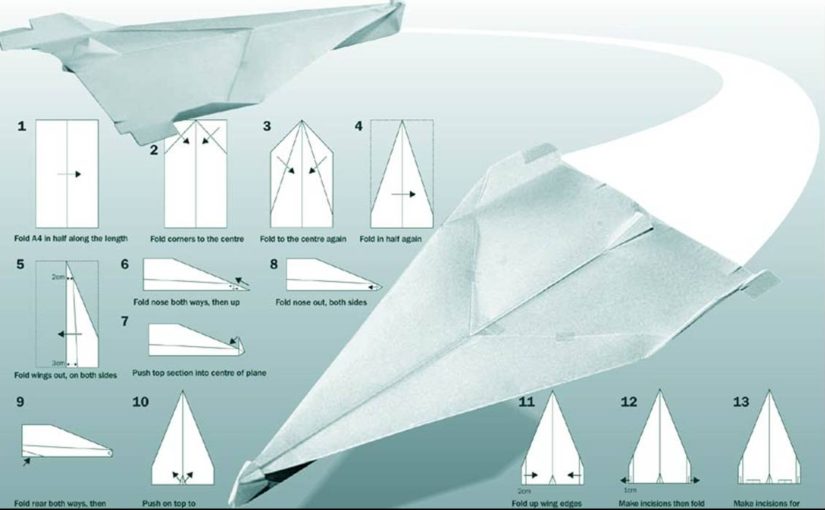When I was attending university, my classmates and I would get drunk and fly paper airplanes. We were all studying engineering. Myself and my buddy Jay were both in a joint program where we studied Aerospace Engineering, while my buddy Peter studied Mechanical Engineering. All told, we had a significant amount of class overlap. As young college students, full of “piss and vinegar”, we would get into all sorts of trouble…
There in the dorms, we would launch our bottle rockets at paper airplanes that we would fly out the windows. The overall goal was to create a paper airplane that would stay aloft the longest. This was maintained by up-drafts and the design of the paper craft.
Let’s look at some of the design features that we incorporated into our tiny paper devices…
Weight and Balance
One of the most important considerations for aircraft (as well as munitions) is the ability for the airplane to be well balanced. This takes into account the center of gravity of the craft relative to the uplifting force on the wing design.
Imagine walking a tight-rope. If you had a large and robust body and butt, the center of gravity would be closer to the rope. Yet if you were tall and skinny with an enormous “pumpkin” head, the center of gravity would be further away from the rope. The distance between the center of gravity of the two body shapes would be different. The longer and taller person might have a more difficult time walking on the tight-rope than the fatter person.
In a like way, the center of gravity of a plane is important. There is a relationship between the center of gravity of the place, and the lift on the wings, as well as the propulsive force at the tail.
In general placing weight forward is desirable
Placing weight forward is desirable.
The place where the paper airplane balances on the tip of your finger is called the Center of Gravity (CG). This is the point of balance. In addition, for aircraft, there is a secondary point of balance. This is a specific CG position known as the Neutral Point. This point provides neutral pitch stability.

Here is the rule of thumb. If the airplane has a CG ahead of the Neutral Point, the plane is stable, if its behind this point its unstable.
As a matter of course, all airplanes without computer assisted flight controls need a CG ahead of their neutral point. Thus almost all airplanes prior to assisted flight controls (invented in the late 1970’s) were designed this way. I guess you could refer to it as a sort of “classical” aviation design.
For rectangular wings the neutral point is ¼ of the distance from the nose to the tail. For delta wings (such as the common dart paper airplane) the neutral point is ½ of the distance from the nose to the tail.
Stability
Stability means the plane, if disturbed, will return to its original state. This is a very important behavioral feature when there are fluid dynamics that alter flight regimes. In general, you want a stable plane. If you don’t have one, you will have a crash. That would really ruin your day.
For pitch stability it means the plane will seek a single airspeed.
A plane which is unstable in pitch will either pitch up into a stall, or nose dive, but won’t settle out anywhere in between. A stable airplane will tend to oscillate up and down a few times, but converge on a steady flight speed.
Many typical paper airplane designs are stable, but just… just… barely.
As a plane becomes more and more stable, it wants to fly faster and faster. To counter this tendency, up-elevator must be used to produce a good trim airspeed. This is why many of the classic paper airplane designs are nearly neutrally stable. Few people realize good pitch stability requires a heavy nose and some up-elevator.
Elevators are flight control surfaces, usually at the rear of an aircraft, which control the aircraft's pitch, and therefore the angle of attack and the lift of the wing. The elevators are usually hinged to the tailplane or horizontal stabilizer. They may be the only pitch control surface present, sometimes located at the front of the aircraft (early airplanes) or integrated into a rear "all-moving tailplane" also called a slab elevator or stabilator. -Wikipedia
The classic aircraft designs rely on the small inherent “up elevator” effect. This effect is known as a positive zero lift pitching moment. It is a direct result from the design of the wing. Often the primary factors are the swept wing, and possibly the airfoil shape.
The problem with paper airplanes is that they are initially designed without a up-elevator effect. Thus many classic paper airplanes are flown with no elevator adjustment. Sometimes they fly well, many times they don’t, and they always have poor stability.
To Improve the plane you incorporate an up-elevator effect
In general, the changes that one must make to a paper airplane to fly well are mostly the same adjustments which make hand launched gliders fly well.
Most people have the crazy idea that a good paper airplane needs no adjustments. You just simply fold up a piece of paper into the shape of an airfoil, and that all there is to it. You make the basic folds and then you are all finished.
This is really unfortunate.
All real airplanes have trim tabs that are used to make small adjustments to the plane. As such, it should be clear that all paper airplanes also need small adjustments to fly their best.
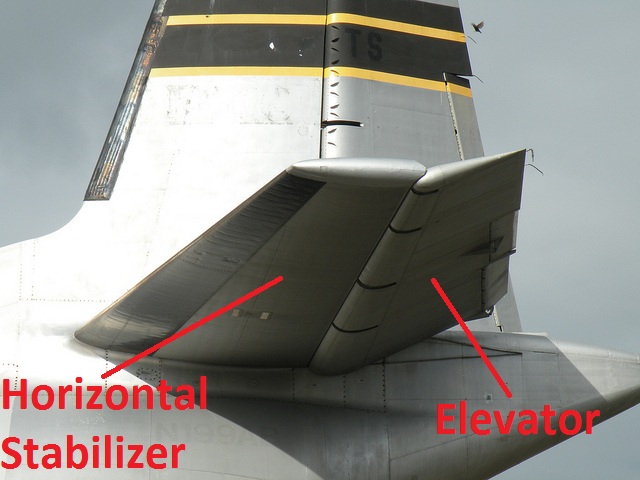
Once, the paper airplane is properly balanced, the following suggestions might help the budding paper airplane designer in keeping their work of art in the air.
Anhedral Wing Design
One of the most common paper airplane mistakes is to leave the wings folded down at an angle. Don’t tell me that you don’t know what I am talking about. It is perhaps the most common way of making paper airplanes.
Folding the wings down along the side at an angle is called “anhedral” shape.
The problem with an anhedral wing design is that it reduces the lateral stability of your paper airplane. To combat this, you can have a different design and shape for the wings. Instead of a anhedral wing, you can have one in a different shape.
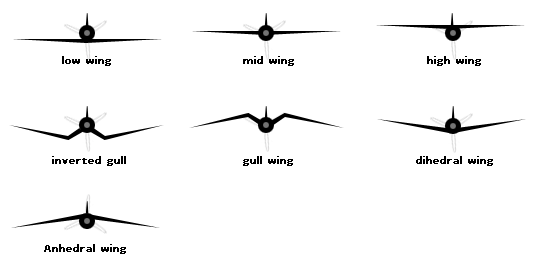
What you want is called “dihedral” wing design which is when the wing tips are the highest part of the wing. The resulting lateral stability will help keep your paper airplane flying straight. Or maybe, at the worst, in a gradual turn.
This is important, as a plane with lateral instability will tend to roll over on its back and crash. Alternatively, it might enter into an ever tightening spiral which becomes a spiraling dive. To prevent this, all you need remember is the simple rule; keep your wing tips up.
Keep your wing tips up.
Sideslip
A slip is an aerodynamic state where an aircraft is moving somewhat sideways as well as forward relative to the oncoming airflow or relative wind. In other words, for a conventional aircraft, the nose will be pointing in the opposite direction to the bank of the wing(s). The aircraft is not in coordinated flight and therefore is flying inefficiently. -Wikipedia
Technically dihedral provides a stabilizing rolling moment due to a condition known as sideslip.
It works like this, if the plane yaws to the left (positive sideslip), the right wing has a slightly increased angle of attack (AOA) because of the dihedral. As this is going on, the left wing’s AOA is decreased (this is most easily imagined if you think about 90 degrees of sideslip). As a result, the resulting rolling moment is to the left, which is stabilizing.
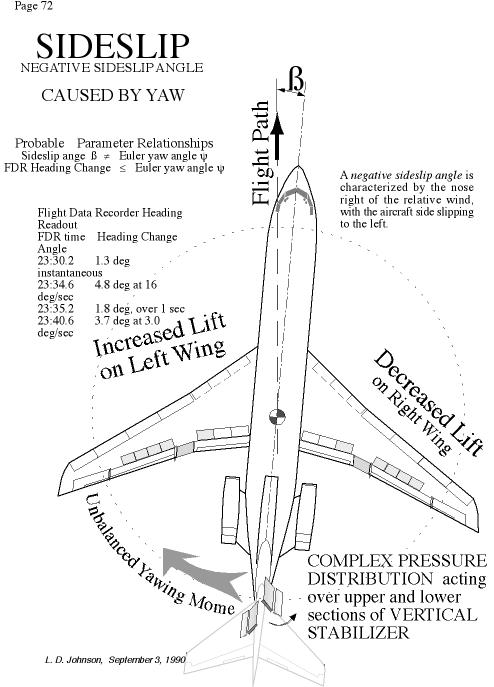
During a level turn, the yaw rate combined with the stabilizing yawing moment (due to yaw rate) results in a little bit of sideslip. The sideslip is positive for right turns, and negative for left turns.
That small amount of sideslip together with a stabilizing rolling moment due to sideslip (dihedral effect) results in the plane wanting to roll out of the turn. Which is exactly what we want.
With anhedral, the plane wants to roll into the turn, resulting in a “graveyard spiral”. This is something that we do not want. (Unless you are designing some kind of gravity directed munition…)
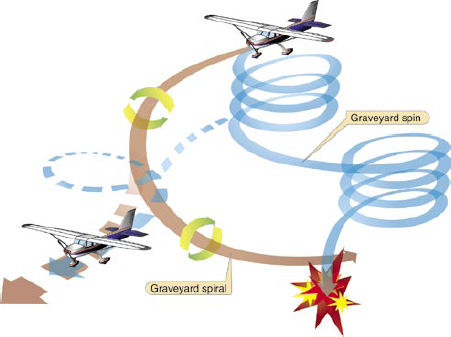
Now, to understand this tendency; the movement to roll into or out of a turn is called the “spiral mode”. This mode is controlled mainly using dihedral.
Most real airplanes have to limit the amount of dihedral they use to keep the Dutch roll mode (which is a rapid left and right oscillation), under control. While dihedral makes the spiral mode more stable, it reduces the damping of the Dutch roll.

You probably won’t have any Dutch roll problems with paper airplanes. This is likely due to increased yaw rate and roll rate damping that is associated with low airspeeds.
Because of this, all paper airplanes should be flown with plenty of dihedral.
Paper airplanes should be designed with plenty of dihedral.
Up-Elevator
You should add a tiny amount of up elevator to the classic pointed nose paper airplanes. This will make sure they don’t dive on you.
If you have the time and materials, you might want to add a few layers of tape or (maybe) a paper clip to the nose of the plane to improve its stability.
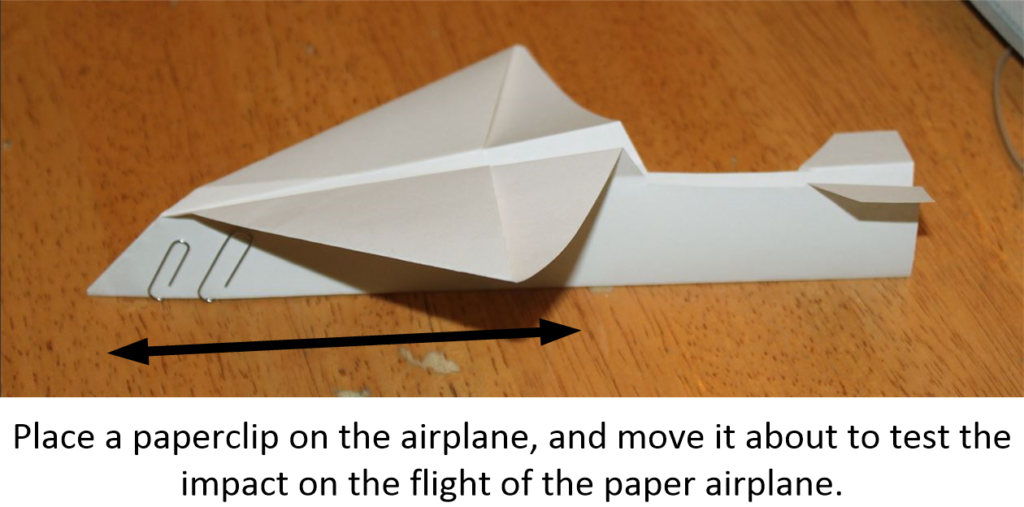
Most “square” paper airplanes have plenty of weight in the nose, and require some up elevator to fly well. The amount of up elevator needed on a paper airplane is a pretty good indicator of its pitch stability.
So, when you build a paper airplane (of any kind) and place a paper clip on the nose. You need to go ahead and take it out for a few flights. Go ahead, make a few flights to determine the best amount of up elevator that is needed.
Now give it a few flights and see how it performs. Practice by moving the weight back slightly. Move it back a few cm, maybe a half an inch or so. Then try again. Keep on doing this. Experiment. See how the weight adds to the stability of the air plane.
The amount of up elevator needed is reduced, and the plane becomes more sensitive to elevator adjustments. Now, take note. When the paper clip has been moved back to a point where you are using nearly no elevator deflection, and you can’t get the plane to fly well, there is a reason. What is going on, is you have the CG at the neutral point (try to balance the plane on a finger, the point where it balances is the neutral point).
Airfoil shape
Contrary to what many people might think, airplane wings are not flat sheets of metal. They are curved. Which means that they are “Cambered”. Being cambered can be explained that if you took a cross section of the wing, it would look like a tear drop shape. In general, the top of the airfoil is rounded and the bottom is kept fairly flat.
That being said, paper airplane wings must be thin to work well.
Overall, the wings on the paper airplane need very little camber. Now, generally any curvature is limited to the front portion of the wing.
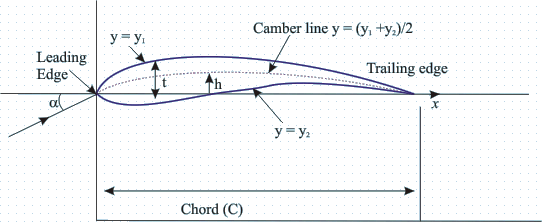
Generally, because most paper airplanes look a lot like “flying wings”, only small amounts of camber are practical. Now, large amounts of camber create nose down pitching moments which need tails to balance.
Hints and Tricks
Try to use a little curvature at the leading edge of the wing. You can use a pencil to round up the leading edges. You really do not need to have a fully cambered airfoil shape on a paper airplane. Typically, paper airplane performance is not noticeably degraded with flat, un-cambered airfoils. You know, the reason for this is likely due to low Reynolds numbers.
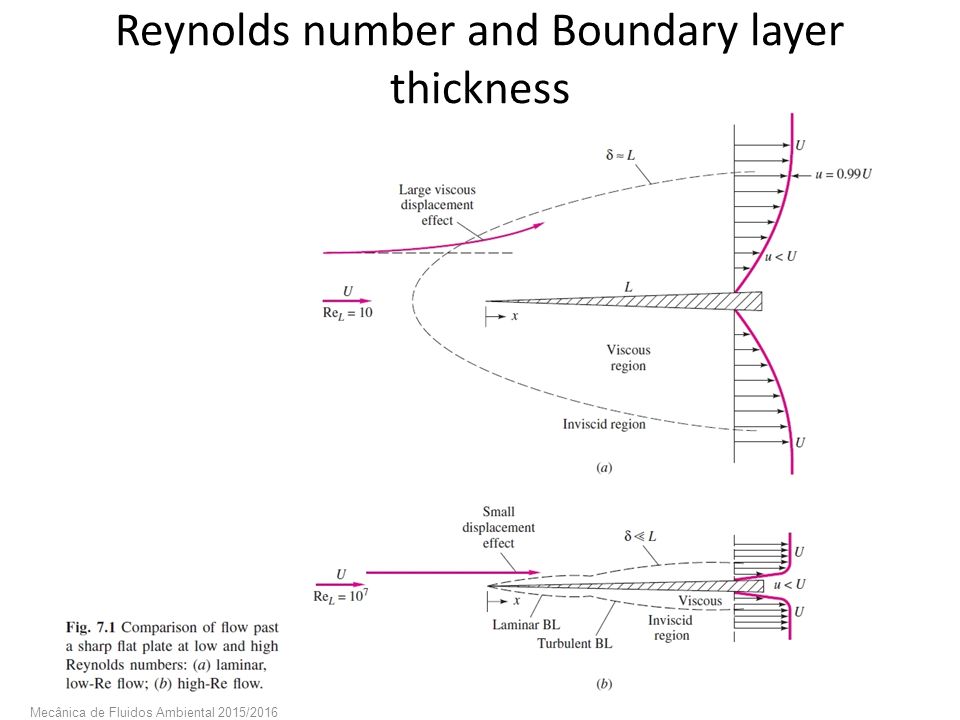
To keep the paper airplane aloft for as long as possible, we need a turbulent boundary layer. Which is to say that the air is mixed up and confused; turbulent. We have to keep in mind that that a large portion of the boundary layer across the front of the wing is laminar flow, but for high lift we need a turbulent boundary layer.
Conclusion
I like to think that the most efficient way to learn is through play. As such, I agree with Fred Rogers. Play is the “work” for children. We learn how to become adults, socialize, think and build things through play.

While we were attending classes in aerospace engineering, it was our “hand’s on” play with paper aircraft that provided a visceral understanding of the basics of flight within the earth’s atmosphere. As such, I have never forgotten such adventures.
Of course, as young men, we were preoccupied in a mix of pursuits that all college boys engage in. Beer, girls, cigars and building paper airplanes (and shooting them down) ranked high on our enjoyable endeavors. I wanted to shot them down with BB guns, but my liberal friends wouldn’t have any of that. However, they had no problems with fireworks, and bottle rockets. Combined, we would tend to get drunk, make experimental paper aircraft designs which we would launch, and then subsequently try to shoot down using manually targeted bottle rockets.
In the process we improved both our aviation design skills, as well as our understanding of basic rocket ballistics. We would chug down a beer as a reward for downing a paper airplane in flames. As I recall, we would also quaff down a beer if we had a close miss… Now, that I think about it, we also drank a beer if we missed by a long shot.
Maybe that is why we were always so drunk after trying to shoot down the airplanes…
Takeaways
- The building of paper airplanes can teach the basics of aviation design.
- Play is an efficient technique to learn.
- Those bottle rockets that lit up the sky decades ago over the Syracuse University campus were actually anti-paper airplane projectiles.
- Physical science isn’t really all that complicated. People tend to use knowledge to obtain power and respect, instead of sharing for mutual benefit.
- Never discount the importance or value of fun.
- Don’t be a “purist”, paper airplanes can incorporate staples, paperclips, tape, glue, cardboard, and other features that could improve the design.
FAQ
Q: Why did you want to shoot down the paper airplanes?
A: We were drunk and at the time, it seemed like an appropriate thing to do. We started with some bottle rockets that one of our friends had. We became so enraptured with the concept that it became a semi-regular event. It was often done surreptitiously in the dark night. We would launch them from the windows in the day room of the dorm where all my friends lived.
A: My friend Peter was always fiddling with his hands. For a while, he began to start making paper airplanes. Over the months together, we started playing with them. We put them in races, and tried to find out how long that they would stay aloft.
A: Not me personally, but there were complaints. It was certainly against campus rules, but the rest of the dorm were either too stoned to complain, or too busy studying to notice. At that time, there weren’t too many busybodies on campus. People had a Laissez-faire attitude about life. It was best summed up as “live and let live”. So you could pretty much live your life on your terms, within limits of course. That is totally unlike today, where the campuses are populated with busybodies, and crybabies that are easily offended about everything.

A: No. Occasionally, I make one to two to amuse a child, but that is the extent of it.
A: No, but it is an interesting concept. If the foil is thick enough it might lend itself to some interesting wing designs.
Posts Regarding Life and Contentment
Here are some other similar posts on this venue. If you enjoyed this post, you might like these posts as well. These posts tend to discuss growing up in America. Often, I like to compare my life in America with the society within communist China. As there are some really stark differences between the two.
More Posts about Life
I have broken apart some other posts. They can best be classified about ones actions as they contribute to happiness and life. They are a little different, in subtle ways.
Stories that Inspired Me
Here are reprints in full text of stories that inspired me, but that are nearly impossible to find in China. I place them here as sort of a personal library that I can use for inspiration. The reader is welcome to come and enjoy a read or two as well.
Articles & Links
- You can start reading the articles by going HERE.
- You can visit the Index Page HERE to explore by article subject.
- You can also ask the author some questions. You can go HERE to find out how to go about this.
- You can find out more about the author HERE.
- If you have concerns or complaints, you can go HERE.
- If you want to make a donation, you can go HERE.
Notes
- Compiled 19JUL18.
- Completed 20JUL18.
- SEO review and Release 20JUL18.

